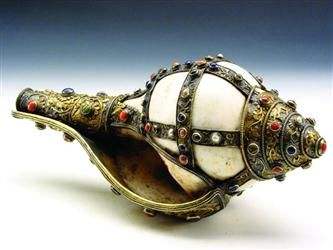Origin and origin of conch
Conch, Tibetan, Mongolian, Naxi, Dai, Manchu, Han and other nationalities play wind instruments. Also known as Li, Fanbei, conch number, law snail and so on. Popular in Tibet, Inner Mongolia, Qinghai, Yunnan, Sichuan, Gansu and other provinces and regions.

Conch has a long history as a musical instrument and has been one of the Buddhist instruments since ancient times. It originated from India and Southeast Asian countries and was introduced to my country with Buddhism.
There are many records in Buddhist scriptures. Kumarajiva (343-413) translated "The Lotus Sutra of the Wonderful Dharma" in Volume 1, which mentioned "blowing the big Dharma conch", and one of the convenient items included: "If you make people make music and play drums and horns, The flute, flute, qin, konghou, pipa, cymbal, and cymbals, all of these wonderful sounds, all hold for offerings.” The first volume of the "Dharma Drum Sutra" translated by Kuna Bhadra (394-468) also has: "Blowing the Dharma Li." After Buddhism was introduced to Tibet, conch shells were used in monasteries.
During the Northern and Southern Dynasties, conch shells were widely circulated among the people in northern my country. During the Northern Wei Dynasty (386-534), the image of music playing conch blowing was already present in the carvings of Yungang Grottoes. During the Sui and Tang Dynasties, conch shells were used in the music of Xiliang, Qiuci, Tianzhu, Funan and Goryeo in the nine and ten pieces of music. "Old Tang Book Music Records" contains: "Bei, Li is also, the capacity can be several liters, and it is played for festival music, and it is also out of Nanman." The musical instruments offered are jade snails, and most of the music offered are closely related to Buddhism. In the poem "Pyu National Music" by Bai Juyi, a great poet in the Tang Dynasty, there is a sentence: "When a jade snail blows a vertebra, and a bronze drum strikes a tattoo". Song Dynasty Chen Yang's "Book of Music" "Fan Bei" article: "Bei, Li is the big one. Today's Fan Music uses it to harmonize with copper cymbals, the so-called Faluo of Shi." Ming Dynasty Wang Qi's "Three Talents Tuhui": " That is to say, with the size of the snail, blowing the sound of the wave, it seems to be made by the shell."
In addition to being used as instruments in Buddhist monasteries, conch shells were also used in the military, labor and entertainment life of ancient northern ethnic minorities. According to the records of ancient Tibetan literature, before the appearance of the tongqin, the faluo was the main instrument in Tibetan Buddhist monasteries. Later, the tongqin took the place of the faluo. In modern times, in Buddhist monasteries, conch shells are only used for performances and Qiangmu performances between chanting sutras.
 渝公网安备 50010702504639号
渝公网安备 50010702504639号